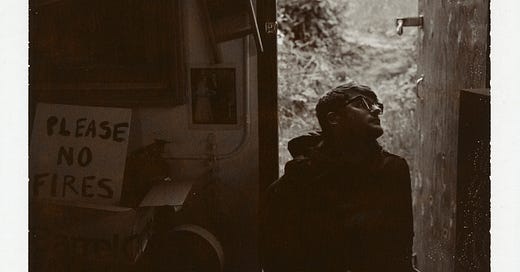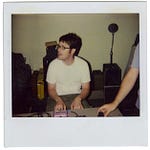This was the last song I wrote for what would be the The King Is Dead sessions; I wrote it when I was living up in Forest Park, just above the St. John’s Bridge. I had a workspace in the lower level of the garage and I remember walking out there one morning to work — it must have been very late in the winter or early spring because I recall looking up at the crowns of the fir trees and it was a clear day and the sun was just above the tops of the trees. I remember being elated by the the sun —the feel of it — as you do when you’ve just lived through an Oregon winter, and marveling momentarily at the path it took across the sky and how our planet on its orbit was forever arcing away and toward the sun. “Bear witness to the arc toward the sun,” was the original second line of this song, which I think I wrote as soon as I sat down with my guitar that day. “Here we come to a turning of the season.”
The strumming pattern came first, which is how it usually goes, and that dovetailed nicely with this thought that had been on my mind that morning, this idea of arcing toward the sun. It felt celebratory, it felt joyful. I was mindful of the community we had on that hill tucked into Forest Park, the one that winded along Springville Road, and I was thinking about my neighbors and the responsibility we have for one another (within reason). There are probably four guitars on this recording, plus one or two tracks of bouzouki. I ended up ditching the electric guitars for the final demo (which is labeled in my files, helpfully, as “A Neighbor’s Burden (Rustic).” The whole vibe might’ve been a bit too…I dunno… Mellencamp-y for our tastes. There’s another identical version that’s titled “Allegiance Sworn.” I clearly was tussling with titles here, before ending up with the obvious: “Don’t Carry It All.” I think I was being careful about the fact that I’d borrowed the song title from a Low song — they do a “Don’t Carry It All” as a b-side to “Dinosaur Act.”
The middle eight changed quite a lot, too. I think it was during rehearsals that we all decided that the chord progression, by that point, had overstayed its welcome a bit, and could use a change. So we did the old “switch the major chords to their relative minors” trick and let that guide the melody. I think it worked in the end. This song is a blast to play live, though I wrote it one or two steps higher than I should have. Even in my sprightly mid-thirties, when this was written, it tended to blow my voice out as soon as I sang it on tour. It was retired — sadly — for a while, for that reason. In recent years, we’ve dusted it off and put it back in the setlist, a full step down. Don’t know why we didn’t do that sooner.













Share this post